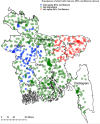Exploring hot spots of short birth intervals and associated factors using a nationally representative survey in Bangladesh
- PMID: 35680970
- PMCID: PMC9184619
- DOI: 10.1038/s41598-022-13193-2
Exploring hot spots of short birth intervals and associated factors using a nationally representative survey in Bangladesh
Abstract
Short Birth Interval (SBI, defined as < 33 months interval between the two most recent births or < 24 months between one live birth to the next pregnancy) is a public health problem in most low- and lower-middle-income countries. Understanding geographic variations in SBI, particularly SBI hot spots and associated factors, may help intervene with tailored programs. This study identified the geographical hot spots of SBI in Bangladesh and the factors associated with them. We analyzed women's data extracted from the 2017/18 Bangladesh Demographic and Health Survey and the healthcare facility data extracted from the 2017 Service Provision Assessment. SBI was the outcome variable, and it was defined as an interval between consecutive births of 33 months or less, as recommended by the World Health Organization. The characteristics of mothers and their partners were the explanatory variables. Moran's I was used to examine the spatial variation of SBI in Bangladesh whereas the Getis-Ord [Formula: see text](d) was used to determine the hot spots of SBI. The Geographical Weighted Regression (GWR) was used to assess the predictors of SBI at the enumeration areas' level. The variables included in the GWR were selected using the exploratory regression and ordinary least square regression model. Data of 5941 women were included in the analyses. Around 26% of the total births in Bangladesh had occurred in short intervals. A majority of the SBI hot spots were found in the Sylhet division, and almost all SBI cold spots were in the Rajshahi and Khulna divisions. No engagement with formal income-generating activities, high maternal parity, and history of experiencing the death of a child were significantly associated with SBI in the Sylhet division. Women's age of 34 years or less at the first birth was a protective factor of SBI in the Rajshahi and Khulna divisions. The prevalence of SBI in Bangladesh is highly clustered in the Sylhet division. We recommend introducing tailored reproductive health care services in the hot spots instead of the existing uniform approach across the country.
© 2022. The Author(s).
Conflict of interest statement
The authors declare no competing interests.
Figures



Similar articles
-
Effects of short birth interval on different forms of child mortality in Bangladesh: Application of propensity score matching technique with inverse probability of treatment weighting.PLoS One. 2023 Apr 21;18(4):e0284776. doi: 10.1371/journal.pone.0284776. eCollection 2023. PLoS One. 2023. PMID: 37083714 Free PMC article.
-
Prevalence and risk factors of short birth interval in Bangladesh: Evidence from the linked data of population and health facility survey.PLOS Glob Public Health. 2022 Apr 22;2(4):e0000288. doi: 10.1371/journal.pgph.0000288. eCollection 2022. PLOS Glob Public Health. 2022. PMID: 36962161 Free PMC article.
-
Clustering of home delivery in Bangladesh and its predictors: Evidence from the linked household and health facility level survey data.PLOS Glob Public Health. 2024 Feb 15;4(2):e0002607. doi: 10.1371/journal.pgph.0002607. eCollection 2024. PLOS Glob Public Health. 2024. PMID: 38359056 Free PMC article.
-
Exploring the association between short/long preceding birth intervals and child mortality: using reference birth interval children of the same mother as comparison.BMC Public Health. 2013;13 Suppl 3(Suppl 3):S6. doi: 10.1186/1471-2458-13-S3-S6. Epub 2013 Sep 17. BMC Public Health. 2013. PMID: 24564713 Free PMC article. Review.
-
Short birth intervals don't kill women: evidence from Matlab, Bangladesh.Stud Fam Plann. 1998 Sep;29(3):282-90. Stud Fam Plann. 1998. PMID: 9789321 Review.
Cited by
-
Short birth interval in the Asia-Pacific region: A systematic review and meta-analysis.J Glob Health. 2024 May 3;14:04072. doi: 10.7189/jogh.14.04072. J Glob Health. 2024. PMID: 38700432 Free PMC article.
-
Effects of short inter-pregnancy/birth interval on adverse perinatal outcomes in Asia-Pacific region: A systematic review and meta-analysis.PLoS One. 2024 Jul 31;19(7):e0307942. doi: 10.1371/journal.pone.0307942. eCollection 2024. PLoS One. 2024. PMID: 39083535 Free PMC article.
-
Wealth-based disparities in the prevalence of short birth interval in India: insights from NFHS-5.Popul Health Metr. 2024 Jul 11;22(1):14. doi: 10.1186/s12963-024-00334-0. Popul Health Metr. 2024. PMID: 38992717 Free PMC article.
-
Women's participation in childbearing decision-making and its effects on short-interval births in Rohingya refugee camps of Bangladesh.Lancet Reg Health Southeast Asia. 2023 Jul 17;15:100250. doi: 10.1016/j.lansea.2023.100250. eCollection 2023 Aug. Lancet Reg Health Southeast Asia. 2023. PMID: 37521319 Free PMC article.
-
Short birth spacing and its impact on maternal and child health in India with urban-rural variation: An epidemiological study using the National Family Health Survey Data.PLoS One. 2025 Jun 27;20(6):e0325461. doi: 10.1371/journal.pone.0325461. eCollection 2025. PLoS One. 2025. PMID: 40577365 Free PMC article.
References
-
- World Health Organization. Maternal Mortality Geneva, Switzerland. (The World Health Organization, 2018).
-
- World Health Organization. Children: Improving Survival and Well-Being. Geneva, Switzarland. (The World Health Organization, 2020).
-
- National Academies of Sciences E, Medicine. Global health and the future role of the United States (2017). - PubMed
-
- Mohammed, S. et al. Short birth interval predicts the risk of preterm birth among pregnant women in Sub-Saharan Africa: A systematic review and meta-analysis. Research Square (2020).
MeSH terms
LinkOut - more resources
Full Text Sources

